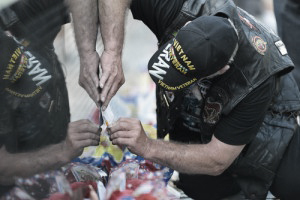 The United States Armed Forces includes five branches of the military–the Army, Air Force, Navy, Marine Corps, and Coast Guard. The official U.S. holiday honoring all who have served in the U.S. Armed Forces is Veterans Day. Observed on November 11th every year as a federal holiday, it recognizes and celebrates the service of all U.S. military veterans.
The United States Armed Forces includes five branches of the military–the Army, Air Force, Navy, Marine Corps, and Coast Guard. The official U.S. holiday honoring all who have served in the U.S. Armed Forces is Veterans Day. Observed on November 11th every year as a federal holiday, it recognizes and celebrates the service of all U.S. military veterans.
History of Veterans Day
President Woodrow Wilson proclaimed November 11th, 1919, as Armistice Day–the anniversary of the signing of the armistice (a truce: an agreement between opposing armies to suspend hostilities so that peace terms can be discussed) that ended World War I, on Nov 11, 1918,
Wilson said, in part, that Armistice Day would “be filled with solemn pride in the heroism” of all who died in service to their country; “and with gratitude for the victory.”
On June 4th, 1926—seven years later—the U. S. Congress passed a resolution asking President Calvin Coolidge to issue another proclamation, making the November 11th observance a legal holiday with appropriate ceremonies. Congress requested that the Armistice Day also be dedicated “to the cause of world peace.”
A World War II veteran from Alabama, Raymond Weeks, came-up with the idea of expanding Armistice Day to include all veterans, not just those who lost their lives in WW I. That was in 1945. President Dwight D. Eisenhower signed a bill into law on May 26th, 1954, establishing the holiday through Congress. On June 1st, 1954, the bill was amended to replace Armistice with Veterans; and the holiday has been celebrated as Veterans Day ever since.
America and Her Soldiers
History shows our world to be a turbulent place, and America’s Veterans were engaged in the following conflicts:
- World War I (1914-1919)
- World War II (1941-1945)
- Korean War (1950-1953)
- Vietnam War (1965-1973)
In more recent times, our younger generations of soldiers have been—and are still—engaged in the military conflicts of the Persian Gulf Wars:
- Operation Desert Storm (1990-1991)
- Operation Enduring Freedom [OEF] (2001-Present)
- Operation Iraqi Freedom [OIF] (2003-2011)
- Operation New Dawn [OND] (9/1/2010-Present)
Our Veterans and Substance Abuse
The human toll exacted on our soldiers is extreme. According to a report on substance abuse amongst our veteran populations published by the U.S. Department of Health and Human Services Administration (HRSA), our veterans are suffering debilitating consequences.
According to the report, as many as 1,000 returned veterans attempt suicide every month—a suicide rate 3 times higher than the general public. The predominant injuries of the current military conflicts include physical injuries, traumatic brain injuries, and amputations. Also suffered is the mental injury of PTSD (Post Traumatic Stress Disorder), considered a lasting consequence of experiencing traumatic events.
The report identifies Operation Enduring Freedom (OEF) and Operation Iraqi Freedom (OIF) veterans as serving longer tours of duty than military personnel in previous wars; with recent reports showing incidences of an increased violent crime rate around military bases by OEF/OIF vets.
The report also identifies the Military Culture as one which emphasizes exceptional mental and physical toughness, an accepted viewpoint that heavy drinking is okay as long as it doesn’t “become a problem”; that there are military commands which react to members seeking substance-abuse treatment with punitive responses–reinforcing the belief that the veterans ought to be able to “fix their problems without assistance.
Also identified in the report were the major military cultural obstacles of negative attitudes toward substance-abuse treatment, and its perceived weakness.
Warning Signs
Veterans returning from their deployment carry the burden of what they have seen, done and experienced in military conflict and war. The report identified the following as warning signs:
- The veteran experiencing nightmares or disturbing dreams
- He or she blaming self for actions in the war zone.
- Experiencing a “loss of innocence”; or a loss of belief in former values.
- Outbursts of rage or anger; irritability.
- The veteran is hyper-vigilant, guarded or is feeling unsafe.
- He or she if feeling alienated from others.
- Stressed-out, apprehensive; anxious; panicky.
- A loss of interest in life; loss of enjoyment in life.
- Increased use of drugs or alcohol.
How to Help
It is understandable how a young man or woman raised to respect life, and taught right from wrong would experience the devastating consequences of violating their own moral code. Witnessing man’s inhumanity to man—while at the same time trying to survive, and honor an oath of military commitment to their country—would cause a person to suffer greatly as a consequence.
Unfortunately, trying to kill the pain—physical and/or emotional—with drugs and alcohol can much too easily result in substance abuse and addiction; more suffering piled on already existing spiritual and mental pain.
For those in need, a few resources are included here:
- Veteran’s Suicide Hotline: 1(800) 273-8255
- Combat Vet Helpline 1 (877) WAR VETS
- To locate a VA Hospital: www.va.gov
- Veterans Centers: http://www.vetcenter.va.gov/index.asp
- Substance Abuse & Mental Health Services Administration : www.samhsa.gov
Narconon Arrowhead proudly offers its drug rehabilitation and education services to our veterans and their families. If you are a Veteran, and you need help, please call us toll-free: 1-800-468-6933
Sources: